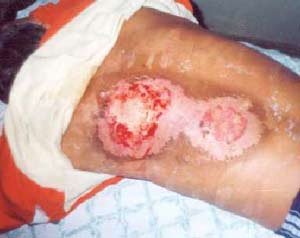Causes of Radiation Burns
When skin is exposed to radiation, often a burn occurs. The worst four types of radiation are ultraviolet light, radio frequency energy, thermal radiation, and ionizing radiation.
There are certain radio frequencies that are absorbed into the body and become changed to heat. The FCC mandates that anything above fifty watts must be monitored and evaluated by radio stations. Ionizing radiation gets in the body, changes and damages cells, and causes redness, or erythema, which is a burn. Uv radiation is most prevalent, and is better known as a sunburn.

Types of Radiation Burns
Prolonged exposure to ionizing radiation often results in radiation dermatitis. It usually happens to patients going through radiation therapy. Acute radiodermatitus Red patches show up on the skin and blistering can occur, too. Chronic radiodermatitus shows up months to years after ionizing radiation exposure. This is often seen in radiologists and technicians who were constantly exposed. Sometimes women who get cobalt radiation as a cancer treatment get eosinophilic, polymorphic, and pruritic eruption.
When the redness, blisters, and lesions begin to fade, radiation acne may occur. Also, months or even years, after radiation treatment, if someone needs chemotherapy, they may have the symptoms of radiation dermatitis reoccur.
Treatment
As you can see, there are different types of radiation burns and causes. Whether a cancer patient, a radiologist, or a scientist, if you or a loved one is suffering from them, there are some things to keep in mind.
- Quick, lukewarm showers are best. No hot baths
- Do not rub yourself dry, only pat.
- No icepacks or heating pads on treatment areas
- No exposure to sun
- Loose fitting cotton clothes are best, and so are cotton sheets
Here are some other helpful tips. Use an electric razor if you are allowed to shave. Do not put any skin care products on before radiation treatments. Use fragrance free moisturizers and other products. Be sure to keep hydrated, and use moisturizers and lotions. These will help your skin not to crack and itch. If you need a bandage, do not use any adhesive ones. You don’t want to cause any more damage.
So, in closing, there are things to do to help you or your loved one who may be suffering from radiation burns. These helpful tips, along with products especially formulated to help radiation patients, may provide a higher level of comfort in difficult times.
For more information and products designed to help radiation burns, visit lindiskin.com.

